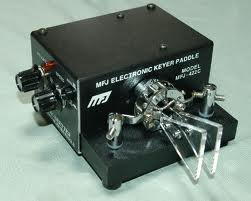
Thursday morning — While organizing the basement a week or so ago I ran into an MFJ paddle/keyer combo that I apparently bought on eBay 7 or 8 years ago. The box was packed with Field Day stuff and had handouts dated 2006 (!). Fortunately, I also located both of my Field Day dipoles with twin lead feedlines (one for 80, one for 40 meters), and my spool of 300-ohm twinlead I bought at a hamfest.
The twinlead is excellent quality stuff, and I have been using it for years on my HF dipole. Of course, I’m not running QRO with it, but it has worked very well for years. Prior to my “temporary” use of 300 ohm twinlead, I had used 450-ohn ladder line. It worked fine — until the insulation betwee the two legs split, or the feedline broke from the dipole. The simple truth is I have had less trouble with the 300 ohm stuff than anything else. I have a couple of bundles of 450 ohm feedline, but I’m not inclined to use it. I see no need to. Back to the  keyer(s).
keyer(s).
MFJ-422D. The MFJ-422D combines the little boxed keyer with the Bencher BY-1/2 or the MFJ-564 Bencher iambic paddle clone. I have owned a couple of the MFJ-564s, and found them to be passable at best. The keys work ok, but they are prone to falling apart if you bounce them around too much (in fairness, the early Bencher keys received the same complaint they were prone to falling apart. Bencher tweaked the design (so I’ve read) to minimize the problem.
The MFJ-422D I found in my Field Day box was built with the MFJ iambic paddle rather than the Bencher one. I had to dig up a 9-volt battery to power the thing, and in my use of it the last week or so it has performed well. I have another MFJ-422D that uses a Bencher BY-1, and they both work equally well. The MFJ paddle however still retains its propensity for the paddles to go hell, west and crooked if you aren’t careful. All in all, it works fine if you use a reasonable fist with it.
 WHAT THE HECK IS THIS? I saw the key at right show up a few days ago on eBay, and I’m still trying to figure out what it is and how it operates (or if it ever operated).
WHAT THE HECK IS THIS? I saw the key at right show up a few days ago on eBay, and I’m still trying to figure out what it is and how it operates (or if it ever operated).
The base resembles that from a Bencher BY-1. There are holes in the left and right side front corners, and the paddles themselves resemble the BY-1. But looking at the rest of the key, I’m not clear just how the hell the rest of this works. Check out  the second photo, and see what you think.
the second photo, and see what you think.
I think the contacts are at the rear posts … somewhere. The interesting thing is that the listing says the key was apparently a prototype, sometime after 1963. I’m tempted to buy the thing just to figure out its operation.
YAESU PARTS ARRIVE. I ordered the parts Monday for my  Yaesu DMU-2000. The problem (as noted below) is a defective crystal filter on the scope board that is installed in the FT-2000. The problem isn’t uncommon I learned. When I called, Yaesu said they had 5 parts in stock, so I bought two of the filters — which were cheap at 71 cents each. (I should have bought them all, lol.)
Yaesu DMU-2000. The problem (as noted below) is a defective crystal filter on the scope board that is installed in the FT-2000. The problem isn’t uncommon I learned. When I called, Yaesu said they had 5 parts in stock, so I bought two of the filters — which were cheap at 71 cents each. (I should have bought them all, lol.)
In the next few days I’m going to open the FT-2000, remove the board and replace the filter. Thankfully the crystal filter isn’t SMT, but standard soldering — though it is very small at that. I’m looking forward to seeing it fixed again.
73 es CUL de ky4z … dit dit …
